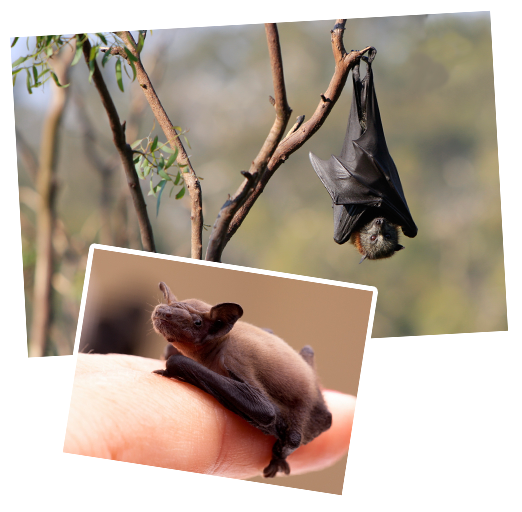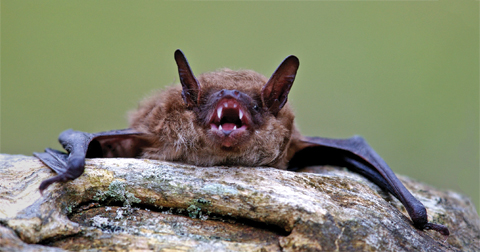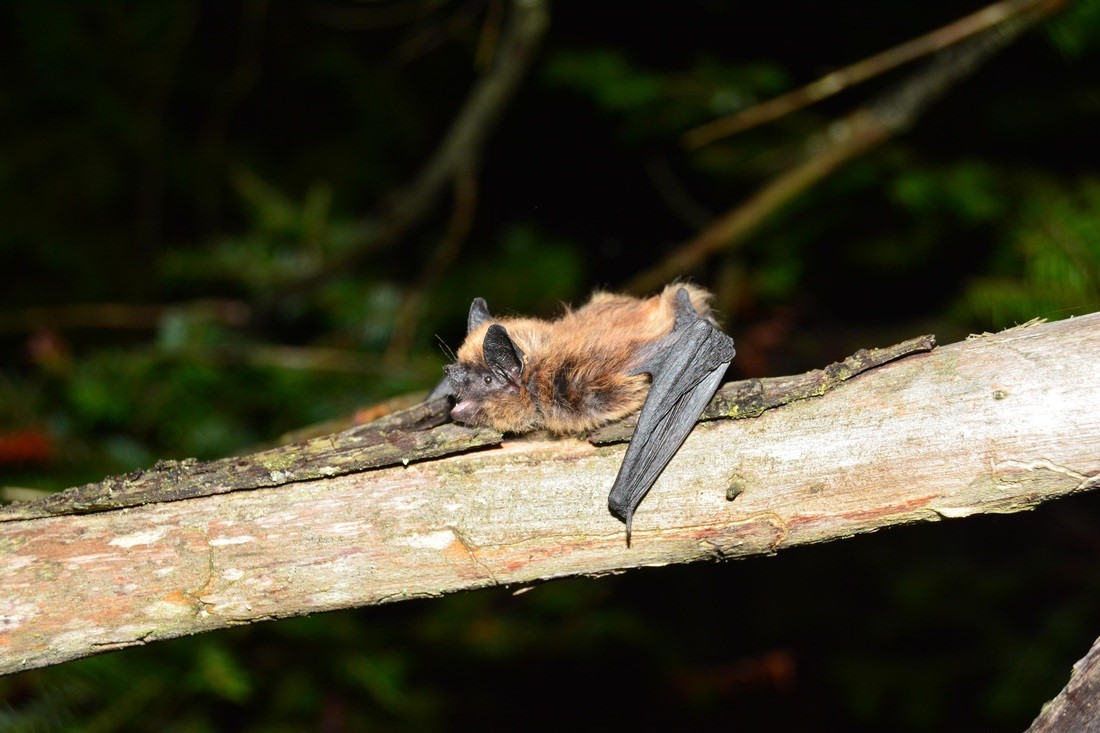GENERAL BIOLOGY
All Canadian bats eat insects, but there are bats in other parts of the world that eat fruit, nectar, fish and other vertebrates. Three species of bat drink blood, none of which are found in Canada. As the primary predator of night flying insects such as moths, beetles, and mosquitoes — Canadian bats can catch hundreds of insects in just one hour. In fact, bats typically consume between 30 to 50 per cent of their body weight in insects in a single night; a pregnant female can consume 100% of her body weight each night. Having a healthy colony of bats can protect gardens and crops from damage and pests.
Bats make up nearly a quarter of known mammal species and are second only to rodents in terms of diversity. And there may be even more out there! Bat species are still being discovered. In fact, we are currently at 1300+ and counting! Most of this diversity in bats is found in the tropics. Bats have a wide distribution and can be found on every continent except Antarctica.
Moreover, bats come in all shapes and sizes.The golden-crowned flying fox (Acerodon jubatus) is the largest in the world with a wingspan of 1.5 metres. The smallest bat is the Bumblebee Bat (Craseonycteris thonglongyai) which weighs around two grams with a wingspan of ~170 milimetres and is smaller than most peoples' thumb.
Bats evolved between 54.8 and 65million years ago and are more closely related to people than rodents.
North America has 48 bat species, with 19 found in Canada. British Columbia has the greatest diversity of bats (16 species) among the provinces; eight of those species do not occur anywhere else in Canada. All bats found in Canada are fairly small. The biggest bat in Canada is the Hoary Bat (Lasiurus cinereus) which weighs 26 grams with a 40 centimetre wingspan. The smallest bat in Canada is the Tricolored Bat (Perimyotis subflavus) which weighs between four and 10 grams with a wingspan of 21 to 26 centimetres.
Bats consume a variety of insects, some of which are important agricultural and forestry pests. In other areas of the world bats are also important for seed dispersal and pollination. In the U.S. alone, it is estimated that bats provide insect control services worth a few billion per year.
LIFECYCLE & ECHOLOCATION
Canadian bats are active from spring to fall. They forage at night and roost in a variety of places during the day which, depending on the species, could be bat houses, human structures, trees (cavities or among the leaves/branches). In late fall most species of Canadian bats will move to swarming sites to mate, then on to caves to hibernate for the winter. Several species don’t hibernate at all, instead migrating south much like many birds do and mate on route back in the spring. Pups are born between June and July and are able to fly within just a few weeks after birth.
To find prey during their lifecycle, bats rely on echolocation. "Blind as a bat" is an expression based on the myth that bats are blind. In fact, bats have great vision and rely on it for many aspects of their lives. To find prey, however, most bats rely on echolocation.
Bats, like dolphins, use high-frequency sounds to navigate and communicate. Bats send out pulses of sound and the returning echoes enable them to detect obstacles in their path. Their skill is such that they are able to avoid items as fine as a human hair. So much for the myth that bats get caught in human hair!
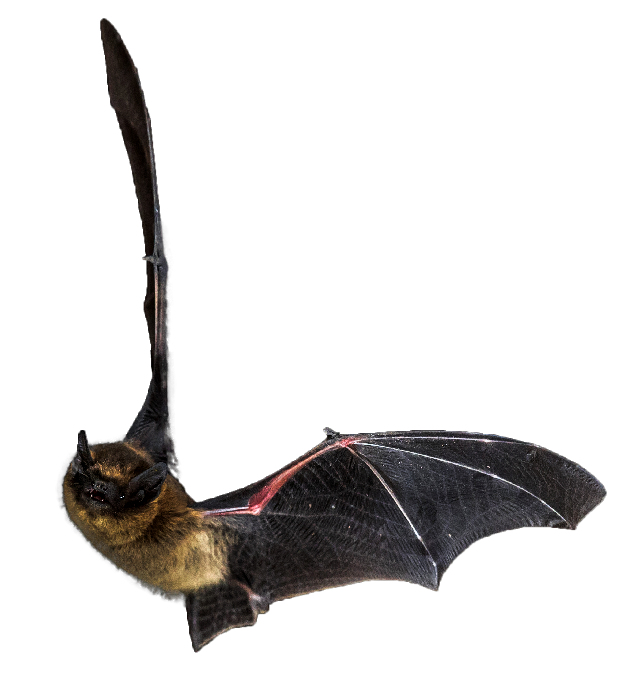
SPECIES PROFILES: CANADA’S BAT SPECIES
Learn more in this comprehensive list of Canada's bats.
- The Big Brown Bat (Eptesicus fuscus)

@ Brock Fenton
Wingspan: 32 to 40 cm
Colour: varies from tan to dark brown
Distribution: most of southern Canada
Status: not at risk of extinction
Habitat: buildings (such as attics and barns), bridges, bat houses, but also in loose tree bark, tree cavities and rock cavities
Life Cycle: Through March and April, females form maternity roosts where they remain until late summer and early fall. After mating in late fall, they hibernate through the winter in caves, mines, and buildings. The females have a gestation period of 60 days (around two months) before giving birth to one or two pups in May through June.
- California Myotis (Myotis californicus)
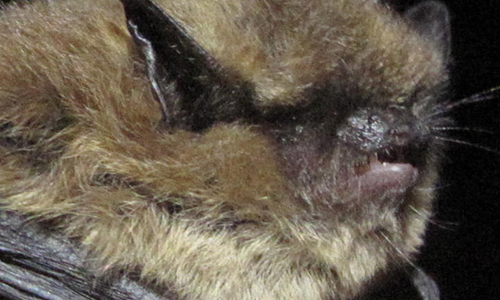
@ Cori Lausen
Size: 7 to 10 cm
Wingspan: 22 to 26 cm
Colour: varies from reddish-brown to dark brown
Distribution: British Columbia
Status: not at risk of extinction
Habitat: rocks and trees, caves, mines, buildings, bridges, shrubs and bat houses
Life Cycle: In early spring, females form maternity colonies in summer roosts. They leave these colonies and mate in late fall where the females undergo delayed fertilization in which they store sperm through the winter and ovulate, and thus become pregnant in the spring. Hibernation occurs in buildings, mines, caves and dead trees. The gestation period is unknown for this species but the females birth one pup in May to early June.
- Tricoloured Bat (Perimyotis subflavus)

@ Brock Fenton
Size: 7 to 9 cm
Wingspan: 21 to 26 cm
Colour: Hair is black at the root, then yellow, with brown tips
Distribution: Ontario, Quebec, New Brunswick and Nova Scotia
Status: Endangered
Habitat: buildings and large trees
Life Cycle: Females form maternity roosts in buildings and large trees. They mate in the fall and then spend most the year in hibernation, anywhere from six to nine months, typically using caves to overwinter individually rather than in groups. Females have a gestation period of 44 to 60 days where they birth one to two pups in June.
- Eastern Small-footed Bat (Myotis leibii)
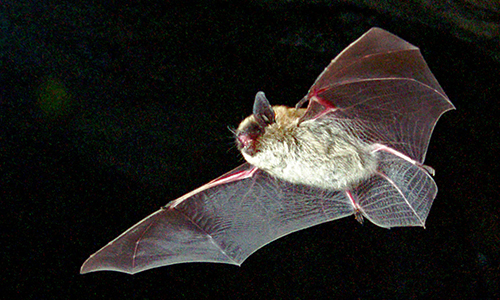
@ Brock Fenton
Size: 7 to 9 cm
Wingspan: 21 to 25 cm
Colour: golden-brown
Distribution: southeastern Ontario and southwestern Quebec
Status: Not at Risk
Habitat: in hilly, mountainous areas, deciduous or evergreen forests and in open farmlands, in loose tree bark, tree crevices and rock crevices
Life Cycle: they roost during the spring and summer in loose tree bark, tree crevices and rock crevices. They mate in the fall, undergoing delayed fertilization over the winter while they hibernate in caves and mines. With a gestation period of six to nine weeks, the females give birth to one pup between May and July
- Fringed Bat (Myotis thysanodes)

@ Jared Hobbs
Size: 8 to 10 cm
Wingspan: 27 to 32 cm
Colour: stiff or “fringed” pale brown fur, with dark brown ears
Distribution: British Columbia
Status: Data Deficient (previously special concern)
Habitat: mines, cliffs, forested areas and buildings
Life Cycle: The migratory pattern of this species is largely unknown, but they are known the roost during the summers in mines, cliffs, forested areas and buildings. The female gestation period is 50 to 60 days before they birth one pup in June or July.
- Hoary Bat (Lasiurus cinereus)
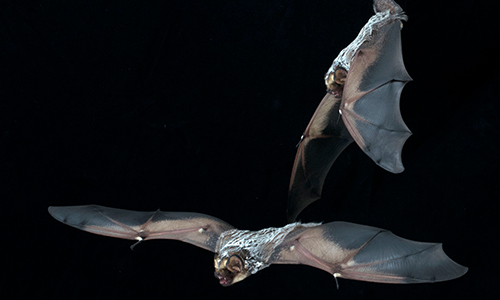
@ Brock Fenton
Size: The largest known bat in Canada, 13 to 15 cm
Wingspan: 36 to 41 cm
Colour: black with brown-grey fur, frosted white tips on its back and tail, and a yellow head and throat
Distribution: British Columbia, Alberta, Saskatchewan, Manitoba, Ontario, Quebec, New Brunswick, Nova Scotia, and Northwest Territories
Status: Endangered
Habitat: hedgerows, trees, and other vegetation
Life Cycle: Roosting in hedgerows, trees, and other vegetation during the summer, they mate in late summer and early fall, storing the sperm as they overwinter. Some hibernate while others migrate south during winter months. Fertilization takes place in the spring and one to four pups are birthed in mid-May to late June after a gestation period of 40 to 56 days.
- Keen’s Myotis (Myotis keenii)

@ Brock Fenton
Size: 7 to 9 cm
Wingspan: 21 to 26 cm
Colour: silky brown fur
Distribution: British Columbia
Status: Data deficient (previously listed as Special concern)
Habitat: cool, wet costal montane forests in a cave, loose tree bark, or even buildings
Life Cycle: Females form maternity roosts in cool, wet costal montane forests in a cave, loose tree bark, or even buildings where they stay from May to mid or late August. After leaving their summer roost, they swarm and mate in caves in September and hibernate in October. The females undergo delayed fertilization and after a gestation period of 40 to 60 days they birth a single pup in early June to late July.
- The Little Brown Myotis (Myotis lucifugus)
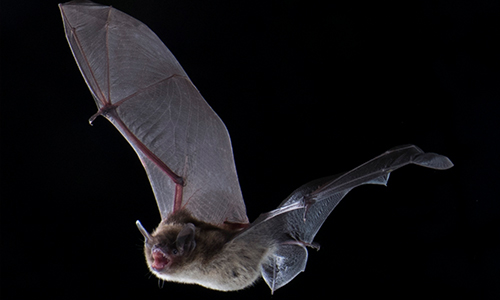
@ Brock Fenton
Wingspan: 22 to 27 cm
Colour: brown fur
Distribution: all parts of Canada
Status: Endangered
Habitat: buildings, tree cavities and bat houses
Life Cycle: In March and April, females form maternity roosts in buildings, tree cavities and bat houses where they roost for the summer until late September. They spend the winter hibernating in dead trees, cliffs, mines, caves and buildings after mating and storing the sperm until spring. After delayed fertilization, they undergo a gestation period of 50 to 60 days before giving birth to a single pup in June or July
- Western Long-eared Myotis (Myotis evotis)
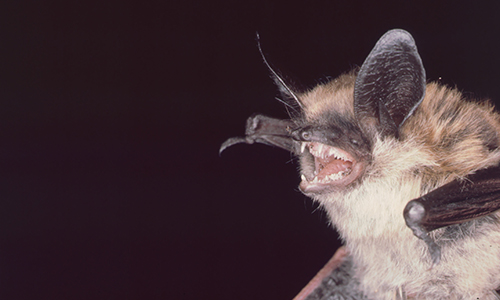
@ Brock Fenton
Size: 8 to 10 cm
Wingspan: 25 to 30 cm
Colour: pale brown fur with a black face and ears
Distribution: British Columbia, Alberta and Saskatchewan
Status: not at risk
Habitat: trees, stumps/snags, caves, and rock crevices
Life Cycle: Females form maternity colonies in trees, stumps/snags, caves, and rock crevices where they live until late September and October. Mating occurs during late fall through early winter and the females experience delayed fertilization. After hibernation, the females gestate for 40 to 60 days during the spring and birth a single pup in late June to early July.
- Long-legged Myotis (Myotis volans)
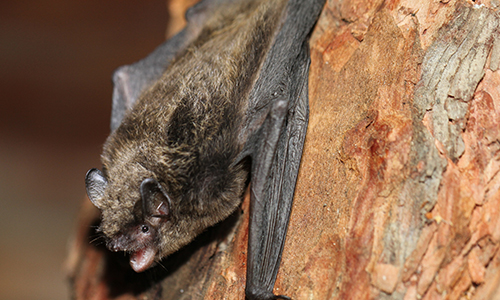
@ Cory Olsen
Size: 8 to 10 cm
Wingspan: 22 to 30 cm
Colour: dark brown
Distribution: British Columbia and Alberta
Status: not at risk
Habitat: buildings and in tree and rock crevices
Life Cycle: Females form maternity roosts inside buildings and in tree and rock crevices until the winter. When it isn’t migrating short distances, it can be found in mines, caves and dead trees. Mating takes place at hibernacula and the females store the sperm over winter and gestate for 50 to 60 days when they emerge in the spring before birthing a single pup in June or July.
- Northern Long-eared Myotis (Myotis septentrionalis)
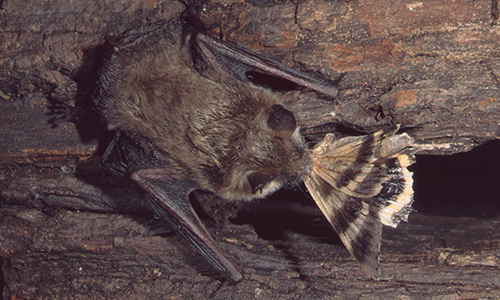
@ Brock Fenton
Size: 7 to 10 cm
Wingspan: 22 to 27 cm
Colour: yellow-brown on their body with large black ears
Distribution: British Columbia, Alberta, Saskatchewan, Ontario, Quebec, Nova Scotia, Prince Edward Island and New Brunswick
Status: Endangered
Habitat: tight crevices and holes of trees, caves and buildings
Life Cycle: Starting in mid-May, females form maternity roosts in tight crevices and holes of trees, caves and buildings where they stay until October. Mating occurs in the fall, and females will store the sperm until they ovulate in May after emerging from hibernation. Their gestation period is 50 to 60 days after which they birth a single pup around June. tight crevices and holes of trees, caves and buildings
- Pallid Bat (Antrozous pallidus)

@ Brock Fenton
Size: 6 to 9 cm
Wingspan: 35 to 41 cm
Colour: stomach is pale, back brown and wings grey with a snout-like nose
Distribution: the Okanagan Valley of British Columbia
Status: Threatened
Habitat: in caves, rock and tree crevices, mines, and buildings
Life Cycle: In the summers, they roost in caves, rock and tree crevices, mines, and buildings. They breed in October and throughout the winter hibernation in buildings and caves. Their emergence from hibernation varies each season and the females birth one to three pups in late spring (May or June) after a gestation period of 53 to 71 days.
- Eastern Red Bat (Lasiurus borealis)
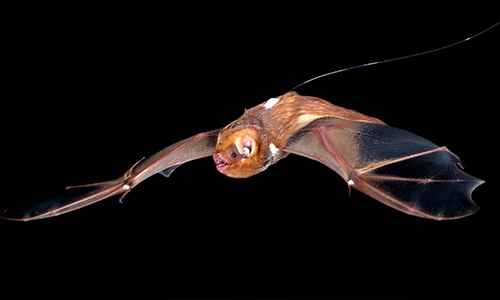
@ Brock Fenton
Size: 9 to 12 cm
Wingspan: 38 to 33 cm
Colour: multi-coloured with yellow-red-orange and yellow-grey fur
Distribution: British Columbia, Alberta, Saskatchewan, Manitoba, Ontario, Quebec, New Brunswick, and Nova Scotia.
Status: Endangered
Habitat: trees and shrubs
Life Cycle: Females form maternity roosts in thees and shrubs where they stay until mating season. When the winter beings approaching, they migrate to warmer regions, after which they return to form maternity roost, gestate for 80 to 90 days and eventually give birth to one to four pups in late May through early June. This is primarily due to the Eastern Red Bat having four mammary glands compared to the usual two.
- Silver-haired Bat (Lasionycteris noctivagans)

@ Brock Fenton
Size: 9 to 11 cm
Wingspan: 27 to 31 cm
Colour: black and brown in colour with frosted tips
Distribution: British Columbia, Alberta, Saskatchewan, Manitoba, Ontario, Quebec, New Brunswick and Nova Scotia
Status: Endangered
Habitat: tree hollows, loose bark, bird nests, buildings and caves
Life Cycle: In the summer, the females form maternity roosts in tree hollows, loose bark, bird nests, buildings and caves. They are a migratory species that roost in mines, caves and dead trees over the winter. The females store sperm over winter followed by fertilization in the spring. Their gestation period lasts 50 to 60 days. They birth one to two pups around June and July.
- Spotted Bat (Euderma maculatum)
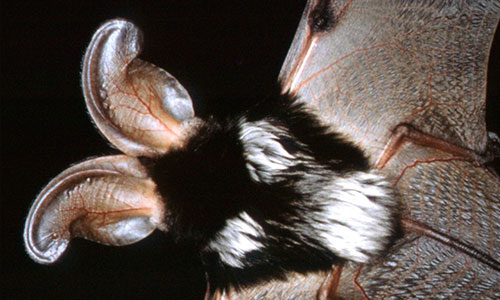
@ Brock Fenton
Size: 11 to 12 cm
Wingspan: 34 to 38 cm
Colour: identified by its three white spots on its black back and its large ears, the largest ears of any North American bat species
Distribution: in Canada, it can only be found in British Columbia
Status: Special Concern
Habitat: small cracks of cliffs and rocks
Life Cycle: Spring and summer roosts are usually in small cracks of cliffs and rocks and their emergence after hibernation in cliffs or after migration during the spring is sporadic. Because of this, the gestation period is unknown, however the females typically give birth to a single pup in June or July.
- Townsends Big-eared Bat (Corynorhinus townsendii)

@ Brock Fenton
Size: 10 cm
Wingspan: 29 to 34 cm
Colour: pale brown-black-grey in colour with two visible glandular swellings on its nose
Distribution: throughout British Columbia
Status: not at risk
Habitat: caves, mines and buildings
Life Cycle: Maternity colonies form in caves, mines and buildings from May through September after which they begin hibernation in similar type roosts or cliffs. Mating occurs during November through February and the females gestate for 56 to 100 days and give birth in late June to mid-July to a single pup.
- Western Small-footed Bat (Myotis ciliolabrum)

@ Cori Lausen
Size: 8 to 10 cm
Wingspan: 21 to 25 cm
Colour: yellow-brown in colour with a black face
Distribution: British Columbia, Alberta and Saskatchewan
Status: not at risk
Habitat: caves, rock crevices, clay banks, buildings, bridges, mines and bat houses
Life Cycle: They like to roost in caves, rock crevices, clay banks, buildings, bridges, mines and bat houses and migrates throughout the winter. Pregnancy lasts around two months with a single pup being born mid-June to late July but very little else is known about this species.
- Yuma Myotis (Myotis yumanensis)
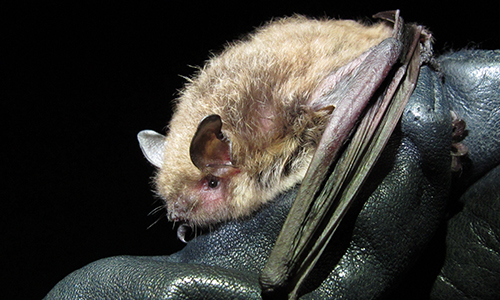
@ Cori Lausen
Size: 8 to 10 cm
Wingspan: 22 to 26 cm
Colour: varies in colour from dark brown to tan-grey
Distribution: British Columbia
Status: not at risk
Habitat: caves, buildings, mines and bat houses
Life Cycle: Females form maternity roosts from April to late August or October, depending on their location, in caves, buildings, mines and bat houses. Over the winter they hibernate in similar roosts: buildings, dead trees and mines. Their gestation period is unknown; however the females give birth to a single pup in May or June.
- Brazilian, or Mexican, Free-tailed Bat (Tadarida brasiliensis)
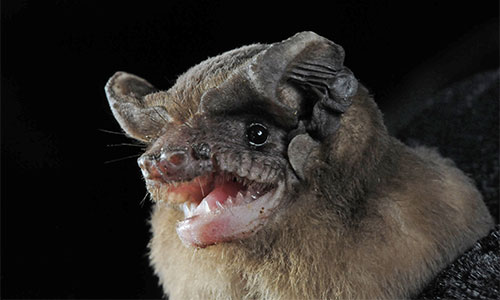
@ Brock Fenton
Size: 8 to 10 cm
Wingspan: 28 cm
Colour: brown in colour with large square ears, a wrinkled upper lip and a prominent tail
Distribution: Only found in Canada on Salt Spring Island in British Columbia
Status: not at risk
Habitat: caves, bridges, attics, buildings, hollow trees and mines
Life Cycle: They can be found from June to September roosting in caves, bridges, attics, buildings, hollow trees and mines before they hibernate in the winter. They mate in March which is followed by a 90-day gestation period after which the females birth a single pup in mid to late June.
WHERE DO BATS GO?
When it comes to finding a companion, bats really go the distance. In early August, male bats peruse caves and mines searching out spots to spend the winter and mate with females. On their search, bats span tens and potentially hundreds of kilometres between overwintering spots. But what happens after the love fest is a bit of a mystery to researchers. We’ve assumed they settle in for hibernation, however, bat banding recoveries show that bats still migrate well into the fall — up to 60 kilometres a night — suggesting bats may hobnob at multiple hibernation sites when the temperature dips before choosing their final resting spot for winter.


